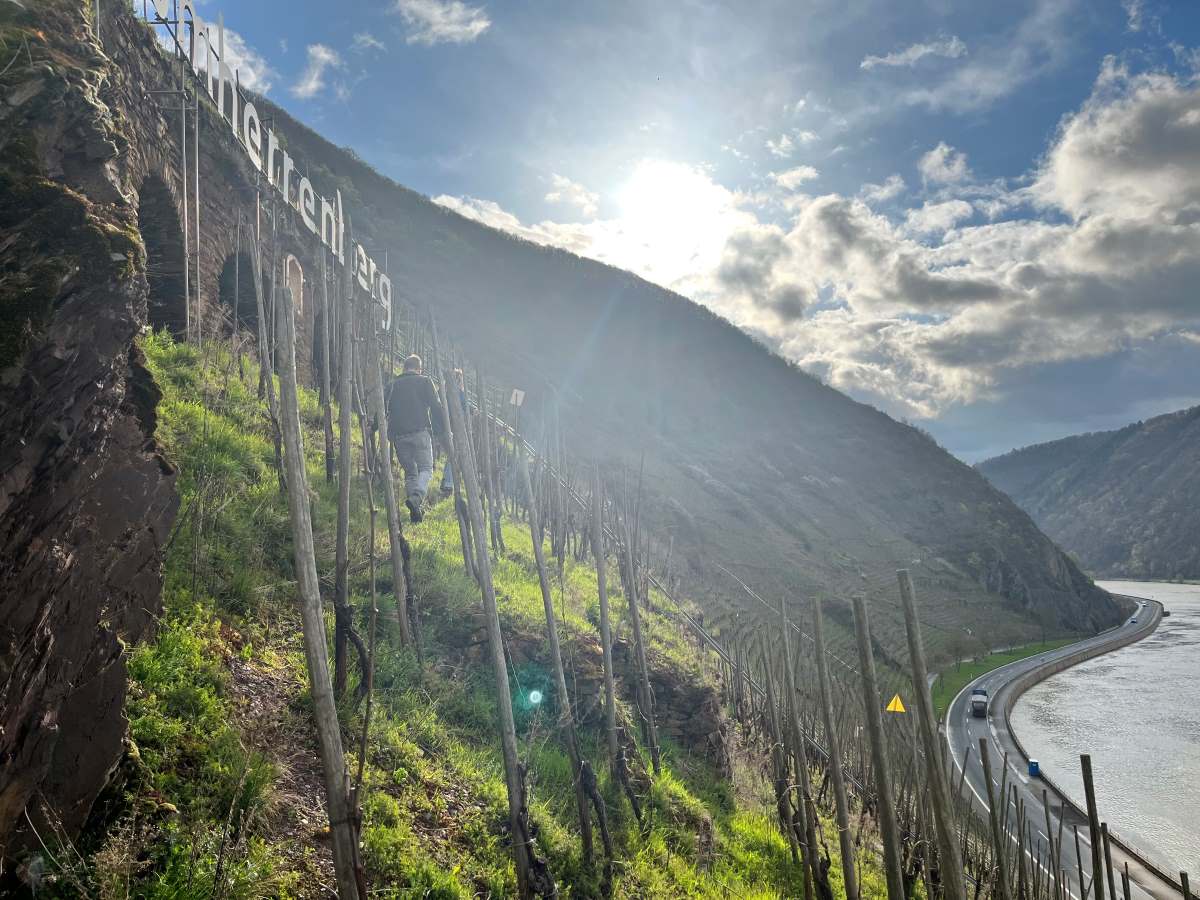
The sun peeks out from behind clouds in the unknown Domherrenberg, a site now farmed by Rosa Curtin and Philip Lardot in the magic Moselle, March 2023.
introduction | Einleitung
Vintage 2021, no matter how you look at it, was serious.
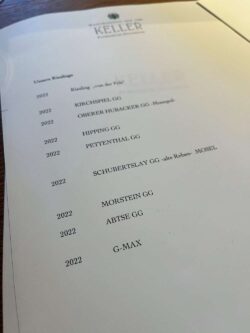
The final page of the 2022 tasting sheet at Keller, from March 2023.
Vintage 2022 is something different.
Vintage 2022 feels to me like joy, in liquid form. The best wines of 2022 almost force you to smile, as quickly and as surely as your leg twitched when the doctor gently tapped you on your knee as a child.
“Lightness” is, without question, the absolute defining characteristic of the vintage, which is something of a shock given that this was a hot vintage (we’ll get to this riddle, “hot vintage, cool wines,” below). You’ll hear the word “classic” thrown around as a descriptor of the vintage, which is partly true, though I don’t think this quite captures the totality of these complex wines.
The wines of 2022 are direct, yet also diffuse and expansive.
Or, in simile form: The wines feel like arrows (that’s the direct part) made of clouds (that’s the diffuse part), whipping around your mouth, showering it with citrus and stone fruit, green herbal details and cooling oceanic breezes.
Time after time, two words kept coming to me, describing in two punches these punchy wines: SATURATE and EVAPORATE… because this is exactly what they do. The wines are all here – a million explosions of joy – and then they are not. A peaceful stillness, a salty reverberation; a mouth salivating for more.
If vintages like 2016 or 2020 presented something of the delicate form of 2022 (though in both cases a bit lazier-feeling) and vintages like 2008 or 2017 presented something of 2022er’s energy (though in both cases more incisive), none of these vintages is a great comparison.
None of these vintages showed the presence and completeness of 2022, especially at this young age. None of them had this outward expansiveness.
I’ll be curious to see how the market responds to the vintage. Do people pass, either because they gorged on 2021 and now have a cellar (or closet) full of monuments to the future, or simply because I’ve yet to utter the words “great” to describe 2022?
I think the reaction to this vintage will say a lot about us, in a way.
Wine dorks of all shapes and sizes bemoan the increasing alcohols of most regions, the ponderous wines that bend under their own weight. We say we value finesse and soil-transparency. And here, with 2022, we have it all – pure energy, delicacy, lightness.
For restaurants – for humans – who actually want to pop bottles and enjoy the voices of the soil, vintage 2022 is ready for you and will not disappoint.
Have no doubt, there will be some epic trophies from this vintage, wines built for the long haul. But yes, these wines will be the exceptions. My best guess is that most of the 2022ers will have shorter lives, though when we are speaking honestly, we are still talking about life-spans of 10 to 15 years.
The point is, you do not have to drink all these wines in the next six months.
The other point is, the wines are so joyous right now that you might want to.
This question came into my head on the flight back: “Can joy be bottled?” The best wines of this vintage feel like a philosophical exploration into this very question.
As absolutely defining and canonical as 2021 was – 2022 is just joy… not to bury the lede, but that is a kind of greatness too, I think.
the weather | das Wetter
This is a paragraph I’ve decided I will keep every year: The first thing to keep in mind when reading about “the weather of a vintage” is that this shit is very complicated – like unfathomably complicated.
As anyone who’s read any vintage report I’ve ever written, you’ll gather I f***ing loathe them. I especially hate simplistic overviews of the weather; the sort of which I’m about to do.
Individual growers, yes, should be able to recount their year, their experiences. But for a critic – or worse yet an importer (gross) – to try and summarize an entire country, or region, well, shame on John, who actually writes all of these reports… unless you like them, in which case I write them.
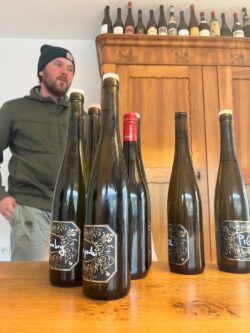
Julian Haart and the ultra-rare, super-collectible, non-gray-marketable BLACK labels that will only be available through vom Boden, pass it on. March, 2023.
Either way, there is no one story for any vintage, period.
With that elegant introduction, here’s my hypocritical attempt to reduce this vintage to one basic story.
A dry-ish winter with not all that much snow or rain developed into about the same spring. Up until April or May this all seemed more or less okay. The flowering was, in parts of Germany, a bit problematic because of some rains, leaving lower yields to begin the vintage. Many, in hindsight, said this would prove to be beneficial as the vintage turned out to be stressful for the vines.
In general though, everything looked good enough. Yes, things were a bit ahead of schedule, “normal” for our new warmer world, but beyond that I would just get the same refrain when I spoke or texted with the growers: “Looks good, we just need some rain.”
Alas, with certain exceptions, this rain never came.
We have with vintage 2022 one of the driest growing seasons of the last 20 to 40+ years. I was in Germany and Europe at large for about six weeks last summer; I can remember only a few rainfalls, none of which were very long nor very severe.
I’ve heard different things from different people in the business, but my overall sense from the growers I spoke to was that the heat of 2022 (and it was a hot vintage, have no doubt) was not as extreme as in 2018, for example. Julian Haart said something to me like: “In 2018 by 11am it was so hot I had to go inside until later in the afternoon; in 2022 I could stay out till 1pm or so. It was warm, but it wasn’t so extreme.”
It does seem that the single most important factor regarding the shape and feel of vintage 2022 was this drought, the shocking and unprecedented lack of rain throughout the growing season. For young vines, it was a disaster, a tragedy. The older vines did better, with their deep roots and their ability to tap into deeper sources of ground water – but even for them it was no fun.
Now, curiously, how this extreme dryness affected the vines and their grapes, is perhaps a bit counterintuitive. The heat with the dryness did not push the vines and the fruit along, steroidally, forcing them into grotesque caricatures of grapes – leaden watermelons dangling in bunches from the vine.
In fact, the extreme dryness did the exact opposite. There was no water to fill up the grapes. In short, this dryness stopped everything. It stopped time.
Simply put, the vines shut down to save themselves.
Keep in mind a vine’s existential urge – its main purpose in life – is to send sugar to the grapes, to eventually attract the birds and spread its seed. Yet in 2022 this avian dance had to be put on hold as the vines simply tried to save themselves. In vintage 2022, for nearly six weeks, the grapes neither accumulated sugar nor lost acidity. Nothing happened.
And so what 2022 presents to us, in a way, is grapes from a very short growing season – thus the freshness of the wines, their extreme lightness and relatively vibrant acidities.
Yet the final months of the season are wildly important; in some ways this is when the true soul of the vintage is shaped. And if in vintage 2021 August and September saved the season by presenting warm and dryer months after the cold and rain-filled months of June and July, in vintage 2022 it was a cool and wet September that saved the vintage. The scholarly journal Mosel Fine Wines describes it as “the miracle of the cool September” in their excellent journal No. 66, published in June of 2023.
These September rains finally offered some nourishment to the wildly dehydrated vines. They drank, presumably, with a deep greed and joy (is this where the joy of the vintage comes from – this moment?).
Importantly, September also presented with cooler days and even cooler nights, which in this narrative is important. This not only helped the vines transition back into a growing phase with more balance, the coolness also prevented ripeness levels from rising up too quickly (or much at all frankly) and kept at bay any fungal pressures. It should be said, however, that with such tiny grapes, nearly empty because of the lack of rain throughout the season, the rains simply began to fill the grapes up – there was less concern for bursting grapes and the rot that can come with this.
The rains increased toward the end of September, making the vintage a bit trickier. By the first or second week of October most estates had finished the harvest.
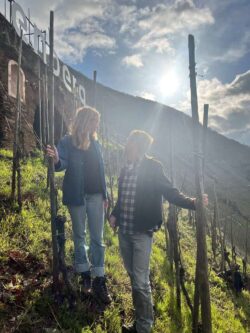
Rosa Curtin and Philip Lardot in the Mosel, March 2023
concentration | die Konzentration
If more than a few growers spoke of the vintage 2021 as something like a quest, a gauntlet to survive – in certain ways, there was nothing you could do in 2022.
If vintage 2021 was a growing season composed of hours and hours of hard work in the vineyard, 2022 was, relatively speaking, easy. More than one winemaker – especially the organic growers – noted that they basically didn’t have to spray. There was no rain, no moisture, no pressure – nothing. For weeks on end, the vines weren’t really growing. What was there to do?
Now, this is not to undermine the hardships and loss; young vines had to be constantly watered and many did not survive. Yet, compared to the near-endless spraying of 2021, vintage 2022 was a cakewalk, if not a particularly nice cakewalk.
Given the lack of spraying needed, it’s probably not outrageous to claim that 2022 is the most ecological vintage of the last 40 years in Germany. (In one way, I suppose, this is also a subtle commentary on how easy it is to be organic in arid landscapes. Germany, the new Spain?)
If the growing season presented one key issue, it was reducing yields. Why? On the one hand, to relieve vine-stress. Think of the vine as the parent and the grapes as the children. With no energy themselves, the vines simply couldn’t support many “children.”
Or, you can visualize it this way: With the vines shut down and no water for the grapes, the question was, do you want three clusters of raisins or one cluster of small healthy berries?
Yet the other reason for smaller yields is that in such dryness, the vines have a hard time pulling anything into the grapes. We tend to think of wet vintages as problematic, with the associated fungal pressure or dilution, yet wet vintages are exactly the vintages where one tends to have very high dry extracts and very high acidities – 2021 being a case in point.
Water is the vehicle for a lot of good stuff.
With the dryness of vintage 2022, the grower also had to consider the yields in terms of the concentration of the grapes. The higher the yields, the lower the concentration. It has to be said that some of the “lightness” of the 2022ers is this very specific issue – lower concentrations paired to the lower alcohols.
One has to also admit it’s all a dance, and a subjective one at that. In the last ten years I think it has become very obvious to most growers and wine dorks that “low yields” aren’t a priori better. Conversely, “high yields” aren’t a priori bad, especially when one is considering elegance and lightness.
It’s very easy to say when a wine is just too dense, lacking in structure or energy or freshness. It’s very easy to say when a wine is just too dilute, thin and vapid. The problem is that most wines are in the middle.
This dance of meaningful concentration with meaningful lightness is the central concern of 2022.
For my part, I very much like the more basic wines of 2022. My palate prefers a certain leanness to weight. I have tasted and re-tasted most of our basic wines over and over again, specifically trying to pay attention to the concentration and I don’t find many lacking, to be honest.
But that’s me; maybe I’m just dull and I interpret this thinness as mineral. I don’t think so, but maybe.
If there is one key to successfully navigating the vintage (beyond the most important: FOLLOW AND SUPPORT GROWERS AND NOT VINTAGES!), it is considering the age of the vines from which the wine was made. With certain exceptions I’m sure, those with older vines made denser wines. This is also the basic key to discerning which wines will go the distance, meaning 10-20+ years – again, look for the old vines.
People lie – old vines don’t.
Yet, even with these yield concerns, by most accounts, the harvest in 2022 was about the same or better than in 2021. Remember the crops of most of the organic growers were absolutely decimated in 2021. For these winemakers, vintage 2022 was something of a godsend, even with its frightening dryness. Weiser-Künstler, as but one example, had nearly double the yields in 2022 as compared to 2021 – and they have a preponderance of old vines.
For this, I am very thankful, for you, for me… but mostly for the growers – the heroes in every story I’ll ever tell.
the wines | die Weine
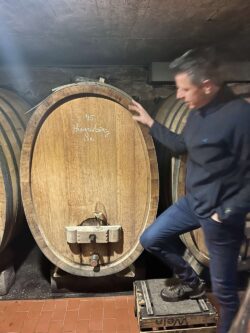
Frank Schönleber in the cellars at the estate, moving his head too quickly, March 2023.
Gutswein!
It’s a funny word, at least to me, maybe to most English speakers. The word “Gutswein” means estate wine – it’s the basic, entry-level wine – though I always chuckle to myself as “gut” is good… It’s immature, I know.
But in 2022, these truly are a special sort of “gut.” Something about the ease and joy of the genre pairs perfectly with the ease and joy of the vintage. They were made for each other in 2022 and in all forms, both off-dry and dry. I think this is something of the heart of the vintage.
If vintage 2022 is pure joy, and the delicately off-dry wines – often labelled as “Feinherb” – the epitome of joy, well, here we have what may be joy-squared, which according to my math is ecstasy.
I have to also confirm the zesty, fruity joy of the dry Gutswein in 2022. Some of these wines are simply so high-toned and expressive, so multifaceted yet petite and juicy. Maybe, just maybe, for the moment, these are my favorites?
I drank the Emrich-Schönleber Gutswein Trocken last night, in about 23 seconds. Granted my wife Jenny helped me, but still. Julian Haart’s “1,000L,” Lauer’s No. 1 and No. 25, Vollenweider’s “Felsenfest,” all so alive and buoyant, saturating, complete.
Stein’s “Blauschiefer” is epic (again, follow the old vines) and Weiser-Künstler’s humble village Trarbacher is simply bonkers gut – this may be one of the most underrated dry Rieslings in Germany. You rock-dorks especially, try and find this wine, it is sublime.
Kabinett
Vintage 2022 also presents some very good Kabinetts. If, with certain exceptions (like the Stein and Wei-Kü mentioned just above) the Gutswein category in 2022 is more fun than it is serious, I think some of the Kabinetts of 2022 are quite legit. I suspect that if we weren’t just coming off 2021, people would be freaking out about these wines.
No, they are not the fortress-Kabinetts of 2021, but, on the other hand, you can actually drink them over the next five to ten years while you wait for the 2021ers to open, someday?

The famous “tasting cabana” at Weingut Hermann Ludes, designed by architect I.M. Pei. Lucky is ye who enters das Cabana.
Florian Lauer has made, for only the second time, a Schonfels Kabinett – he’s also made the normal Kupp No. 8, a tiny amount of village-level Kabinett No. 87 and a tiny bit of Lambertskirch. Look for them and if you can find them, pounce.
Julian Ludes and his uncle Hermann have, once again, made six different Kabinetts, though they seem to be the exception in terms of the Kabinett deep-dive. Julian Haart is back to his two single-vineyard Kabinetts along with the more-basic “J.J.” Kabinett. Emrich-Schönleber, Keller, Stein, Vollenweider and Weiser-Künstler are back to their normal array of Kabinetts, including a few special single-vineyard wines.
The seriousness, the quality of the 2022 Kabinetts (as with the 2021 Kabinetts before them) also comes as almost a by-product of this very unique moment in German wine culture. All this may seem very grandiose and vague to the average consumer, but it is not at all vague for the grower. The truth is that many growers can now command the same amount of money with their Kabinetts as they can with any other wine; the relationship between the Prädikat and the cost of the wine has been largely shattered. This is the game-changing fact and it means, quite simply, that entire new parcels and vineyards and grapes are open now for this genre.
And you can taste this again in 2022, as in 2021.
For those of you who want to read a rather verbose historical and financial history of the Kabinett over the last quarter century, please see my 2021 vintage report here.
Spätlesen and chicken
As with last year, I can use this intro.
“Let’s speak openly: It wasn’t until sometime in the late 1990s and early 2000s that Spätlesen became a dessert wine. The new ease of reaching higher ripeness levels, the influence of Robert Parker and the 100-point scale, our own seemingly insatiable love of sweetness. If all these things pushed many growers a bit too far in the first decade of this new century, for some reason the Spätlese as a genre seemed to have suffered the most. They became almost grotesque caricatures of what they once were; folds of textural, voluptuousness where there used to be a savvy leanness, a spirited mid-palate.”
Be warned, John and Collin are going to make the “Spätlesen” their new mission. Especially with the last two vintages, I have to admit the category has changed so much you might not even recognize it.
For those of you that have forsaken Spätlese, John and Collin and I warmly welcome you back with this invitation: Try the new “old” Spätlesen!
If in vintage 2021 the Spätlesen were spectacular yet fairly rare, with some exceptions in vintage 2022 they are very good yet even rarer. Remember, our “miracle” of a September was cool, thus ripeness levels just did not increase – and you had to have very low yields to get the Oechsle to rise. And while the growers were waiting, the rains became more prominent, toward the end of September and into October.
So Spätlesen and Auslesen – anything much above the Kabinett level, are quite rare in vintage 2022. They are rare birds, but they are also special and worth being on the lookout for.
Red wines and the “GGs” and Grand Cru Dry White Wines…
For the most part, these early vintage reports have to basically ignore two important categories: Red wines and the “GGs” or Grand Cru dry wines. Why? Well, because when we’re trying to get an initial sense of the vintage, in April or May of the following year, these wines are still very, very young. If the whites have finished the fermentation, they are still on their gross lees and embryonic. The red wines even moreso.
So while a final verdict will have to wait, there is good reason to think these could be a very strong part of the vintage. First, a ripe, warmer vintage will play into these categories. If the acidities are vibrant enough to support Kabinetts, then they are certainly formidable enough for superb dry red and white wines. The question I suppose for these wines and this vintage is one of ripeness and of concentration. For the top wines, there is good reason to believe these may be very, very good – something in line with the 2020 dry wines, yet with a bit more focus and cut.
These could be thrilling, though we’ll have to wait and see.
As always, THANK YOU for reading. If you have any questions or comments, email us anytime at info@vomboden.com. We always love to hear from you.
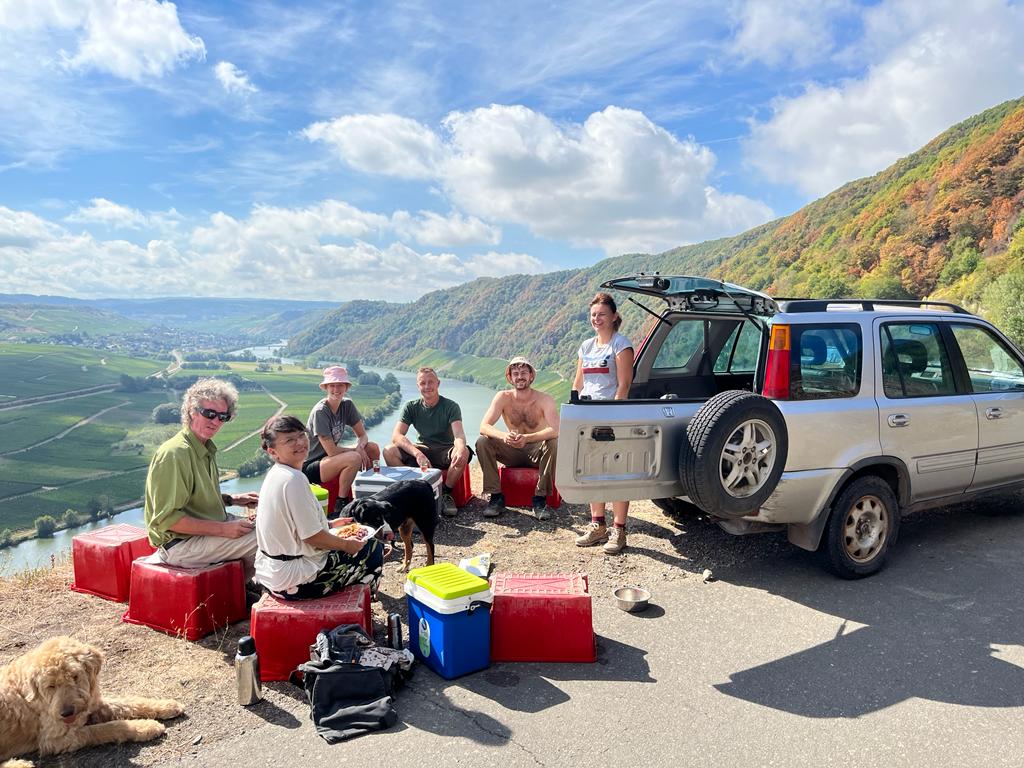
Stein and Philip Lardot, high above Piesport, in September of 2022.